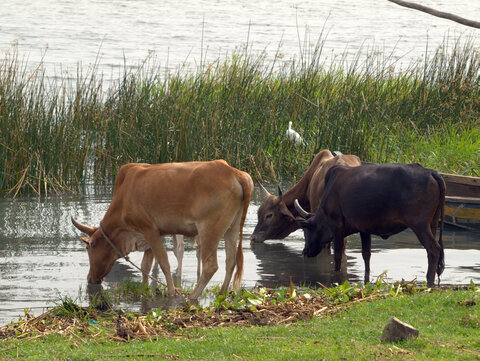Will treating my cattle with insecticide poison them or me?

All insecticides contain substances that are potentially harmful to humans and animals. So they must be handled with the care, and everyone involved with treating the cattle or targets must be properly trained. It is equally important that you read and follow the manufacturer’s instructions, and do not use the formulation after the expiry date.
The insecticide applied to targets, traps and cattle to control tsetse are all synthetic pyrethroids, such as deltamethrin, alphacypermethrin, cyfluthrin and flumethrin. Pyrethroids are less dangerous to people compared to say organophosphate dips, but they do pose a greater hazard to aquatic wildlife.
Human safety
Hazardous chemicals can get into the body through the skin, by swallowing and by breathing in vapour. Contact with pyrethroids can cause tingling, especially on the face, itching with red blotchy skin, excessive salivation and eye watering. To prevent this happening, operators should wear non-lined synthetic rubber gloves, Wellington boots and waterproof leggings and overcoat when handling concentrated formulations or dilute dipwash.
In practice, this level of protection is difficult to achieve in remote areas of Africa, especially when it is very hot. But, protective gloves, overalls and boots should be regarded as a minimum.
If you get insecticide on your skin or clothing, wash the area immediately and put on clean clothes and protection equipment. Important working practices include:-
Handling the concentrate in the open air or a well-ventilated place;
Making sure the diluted formulation is well mixed and maintained at the proper strength;
Whenever you take a break, wash thoroughly, especially before eating, drinking, smoking or using the toilet.
Never leave insecticide in unmarked containers.
If there is a spillage, then use sand, earth or sawdust to soak up the liquid and then place this in a labelled, sealed container.
Anyone seeking medical advice should take the product label, so that the doctor knows which chemicals are involved.
Environmental safety
Pyrethroids represent a particular hazard to aquatic environments. The relatively small amounts applied to targets and cattle do not in themselves pose any great threat. However, the large volumes of insecticide in a dip tank do, and so it is important that the design of the tank, and the disposal of used dipwash, does not contaminate water sources.
The diptank should have a piped supply of clean water for top up, decontamination and rinsing and you should make sure that the dipwash cannot siphon back into the pipe. The tank should be at least 10 m from streams, ditches and drains, and 50 m from wells, springs and boreholes.
While not being ideal, soakaways are probably the most practicable method of disposing of used dipwash in the remote areas of Africa. These should be sited at least 50 m from springs, wells and boreholes and 10 m from watercourses.